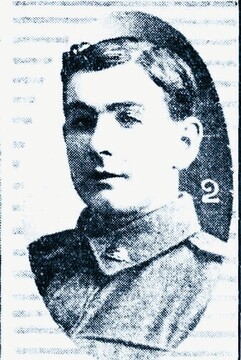
YOUNG, Clarence Victor
| Service Number: | 6912 |
|---|---|
| Enlisted: | 8 February 1917 |
| Last Rank: | Private |
| Last Unit: | 21st Infantry Battalion |
| Born: | Bendigo, Victoria, Australia , August 1898 |
| Home Town: | Melbourne, Melbourne, Victoria |
| Schooling: | Queensberry Street State School, Carlton, Victoria, Australia |
| Occupation: | Labourer |
| Died: | Killed in action, Belgium, 22 March 1918 |
| Cemetery: |
Berks Cemetery Extension Plot II, Row A, Grave 42. |
| Memorials: | Australian War Memorial Roll of Honour |
World War 1 Service
| 8 Feb 1917: | Enlisted AIF WW1, Private, 6912, 21st Infantry Battalion | |
|---|---|---|
| 11 May 1917: | Involvement Private, 6912, 23rd Infantry Battalion, --- :embarkation_roll: roll_number: '13' embarkation_place: Melbourne embarkation_ship: HMAT Ascanius embarkation_ship_number: A11 public_note: '' | |
| 11 May 1917: | Embarked Private, 6912, 23rd Infantry Battalion, HMAT Ascanius, Melbourne | |
| 22 Mar 1918: | Involvement Private, 6912, 21st Infantry Battalion, --- :awm_ww1_roll_of_honour_import: awm_service_number: 6912 awm_unit: 21st Australian Infantry Battalion awm_rank: Private awm_died_date: 1918-03-22 |
Help us honour Clarence Victor Young's service by contributing information, stories, and images so that they can be preserved for future generations.
Add my storyBiography contributed by Stephen Brooks
Clarence was the son of Christopher and Mary Young and had been born at Bendigo, Victoria. His parents were both deceased for at least three years when he enlisted as an 18-year-old in 1917.
He stated his guardian and next of kin was his elder married sister, Christina French, who was 31 years of age when Clarence enlisted. Three of his older brothers had already joined the AIF.
His brother, 1425 Pte. Thomas Young 14th Battalion AIF was killed in on 29 March 1917, aged 31.
Clarence joined the 21st Battalion at the front during November 1917. He was killed in action in Belgium four months later, at the start of the 1918 German offensive ‘Operation Micheal’
Another brother Francis Young 8th Battalion was hit by shrapnel in the hip bone at Gallipoli and returned to Australia incapacitated in late 1915. Another brother, George Philip Young, was returned to Australia during 1918 by the General Officer Commanding AIF, General Birdwood, for ‘family reasons’, probably due to the fact he had two brothers killed and one badly wounded.










